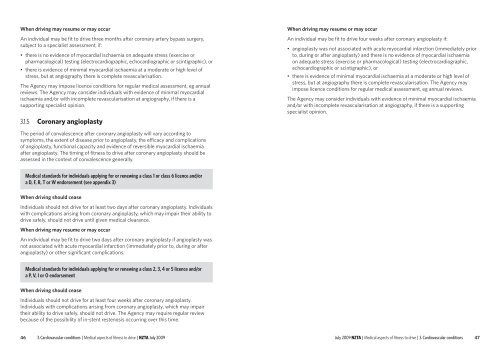Medical aspects of fitness to drive a guide for medical practitioners
Medical aspects of fitness to drive a guide for medical practitioners
Medical aspects of fitness to drive a guide for medical practitioners
Create successful ePaper yourself
Turn your PDF publications into a flip-book with our unique Google optimized e-Paper software.
When driving may resume or may occur<br />
An individual may be fit <strong>to</strong> <strong>drive</strong> three months after coronary artery bypass surgery,<br />
subject <strong>to</strong> a specialist assessment, if:<br />
• there is no evidence <strong>of</strong> myocardial ischaemia on adequate stress (exercise or<br />
pharmacological) testing (electrocardiographic, echocardiographic or scintigraphic), or<br />
• there is evidence <strong>of</strong> minimal myocardial ischaemia at a moderate or high level <strong>of</strong><br />
stress, but at angiography there is complete revascularisation.<br />
The Agency may impose licence conditions <strong>for</strong> regular <strong>medical</strong> assessment, eg annual<br />
reviews. The Agency may consider individuals with evidence <strong>of</strong> minimal myocardial<br />
ischaemia and/or with incomplete revascularisation at angiography, if there is a<br />
supporting specialist opinion.<br />
3.1.5 Coronary angioplasty<br />
When driving may resume or may occur<br />
An individual may be fit <strong>to</strong> <strong>drive</strong> four weeks after coronary angioplasty if:<br />
• angioplasty was not associated with acute myocardial infarction (immediately prior<br />
<strong>to</strong>, during or after angioplasty) and there is no evidence <strong>of</strong> myocardial ischaemia<br />
on adequate stress (exercise or pharmacological) testing (electrocardiographic,<br />
echocardiographic or scintigraphic), or<br />
• there is evidence <strong>of</strong> minimal myocardial ischaemia at a moderate or high level <strong>of</strong><br />
stress, but at angiography there is complete revascularisation. The Agency may<br />
impose licence conditions <strong>for</strong> regular <strong>medical</strong> assessment, eg annual reviews.<br />
The Agency may consider individuals with evidence <strong>of</strong> minimal myocardial ischaemia<br />
and/or with incomplete revascularisation at angiography, if there is a supporting<br />
specialist opinion.<br />
The period <strong>of</strong> convalescence after coronary angioplasty will vary according <strong>to</strong><br />
symp<strong>to</strong>ms, the extent <strong>of</strong> disease prior <strong>to</strong> angioplasty, the efficacy and complications<br />
<strong>of</strong> angioplasty, functional capacity and evidence <strong>of</strong> reversible myocardial ischaemia<br />
after angioplasty. The timing <strong>of</strong> <strong>fitness</strong> <strong>to</strong> <strong>drive</strong> after coronary angioplasty should be<br />
assessed in the context <strong>of</strong> convalescence generally.<br />
<strong>Medical</strong> standards <strong>for</strong> individuals applying <strong>for</strong> or renewing a class 1 or class 6 licence and/or<br />
a D, F, R, T or W endorsement (see appendix 3)<br />
When driving should cease<br />
Individuals should not <strong>drive</strong> <strong>for</strong> at least two days after coronary angioplasty. Individuals<br />
with complications arising from coronary angioplasty, which may impair their ability <strong>to</strong><br />
<strong>drive</strong> safely, should not <strong>drive</strong> until given <strong>medical</strong> clearance.<br />
When driving may resume or may occur<br />
An individual may be fit <strong>to</strong> <strong>drive</strong> two days after coronary angioplasty if angioplasty was<br />
not associated with acute myocardial infarction (immediately prior <strong>to</strong>, during or after<br />
angioplasty) or other significant complications.<br />
<strong>Medical</strong> standards <strong>for</strong> individuals applying <strong>for</strong> or renewing a class 2, 3, 4 or 5 licence and/or<br />
a P, V, I or O endorsement<br />
When driving should cease<br />
Individuals should not <strong>drive</strong> <strong>for</strong> at least four weeks after coronary angioplasty.<br />
Individuals with complications arising from coronary angioplasty, which may impair<br />
their ability <strong>to</strong> <strong>drive</strong> safely, should not <strong>drive</strong>. The Agency may require regular review<br />
because <strong>of</strong> the possibility <strong>of</strong> in‐stent restenosis occurring over this time.<br />
46 3. Cardiovascular conditions | <strong>Medical</strong> <strong>aspects</strong> <strong>of</strong> <strong>fitness</strong> <strong>to</strong> <strong>drive</strong> | NZTA July 2009<br />
July 2009 NZTA | <strong>Medical</strong> <strong>aspects</strong> <strong>of</strong> <strong>fitness</strong> <strong>to</strong> <strong>drive</strong> | 3. Cardiovascular conditions 47
















